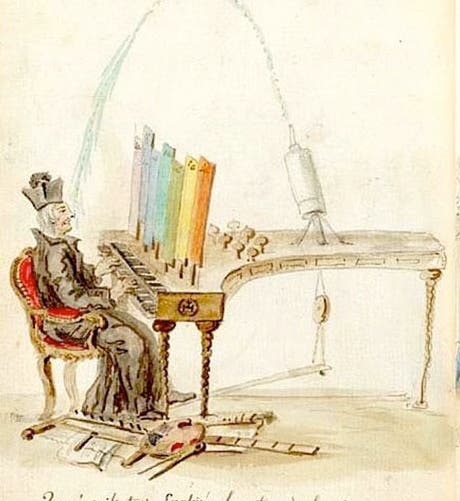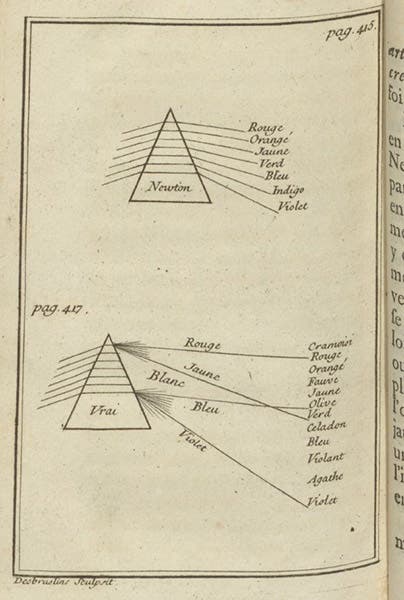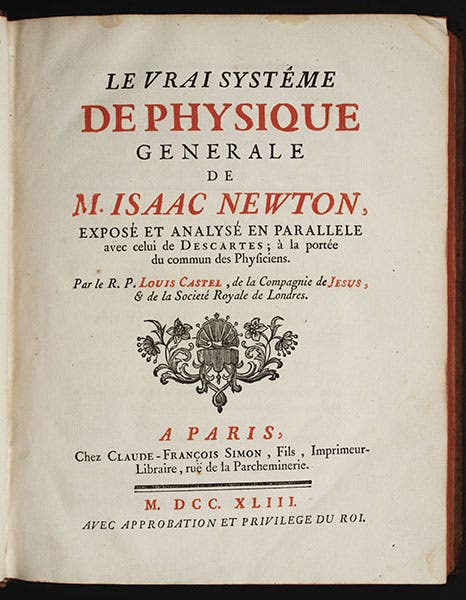Scientist of the Day - Louis-Bertrand Castel
Louis-Bertrand Castel, a French natural philosopher, was born Nov. 15, 1688. Castel was a Jesuit, one of many of his order to engage in scientific pursuits. In 1725, he wrote a letter in which he proposed an idea for an “ocular harpsichord”, an instrument that would play colors instead of sounds. This was not an entirely new proposal, as Athanasius Kircher (a Jesuit of the previous generation) had wondered about making “visible music,” and Isaac Newton (most definitely not a Jesuit) had noticed the parallel between the 7 colors of the visible spectrum and the 7 notes of the musical scale. But neither Kircher nor Newton actually contemplated building an instrument that would play thirds and fifths of red, blue and yellow.
Castel followed up his initial letter of 1725 with further thoughts. An ocular harpsichord might have small pieces of colored glass covered by tiny curtains; when the proper key was pressed, the curtain would be lifted and light would shine through the glass. The great challenge, of course, would be to figure out which colors corresponded to which musical notes, so that a deaf person, viewing the play of colors, would experience melodies and harmonies, just like a listener exposed to conventional music. Supposedly, these further thoughts appeared in a treatise, L'optique des couleurs, published in 1740. However, we acquired this work several years ago (second image, above), and if there is a description there of his color instrument, I have not yet found it. There is a great deal of discussion and criticism of Newton’s color theory, however, which is not too surprising, coming from an adherent of Descartes’s theory of light and color.
There is also an interesting plate in the book, showing diagrams of a pair of spectra (third image, above). The upper explanation is that of Newton, with 7 colors; the lower diagram, labelled “vrai” (true) has labels for 12 colors, which just so happens to be exactly what one would need for a “chromatic” chromatic musical scale.
It is not clear whether Castel ever built an actual ocular harpsichord, or instead just talked about it. The latter was more the Jesuit way – Kircher and Gaspar Schott and many of the other great Jesuit inventors rarely built the magic lanterns, speaking trumpets, and perpetual motion machines that they discussed so extensively in their treatises; invention was more of a mental exercise for the Jesuits than a contribution to technology. However, there does exist a caricature of Castel, made by a contemporary, that shows him playing what is almost certainly an imaginary color keyboard (first image). Imaginary of not, it does tell us that Castel was associated in his time with an instrument that played colors.
In addition to Castel’s Optique des couleurs, we have two other treatises by Castel, the title pages of which we display here. It is evident just from the title pages that Castel spoke his own mind quite freely and was not shy about taking on the likes of Isaac Newton, Gottfried Leibniz, and Voltaire. Castel's quarrels with his contemporaries seems to have arisen from his belief that they relied too much on singular experiments and were missing the big picture, which can be revealed only by analogy. Demonstration by analogy was definitely out of favor in Enlightenment France, which is probably why Castel and his ocular harpsichord seem to have rapidly disappeared from the historical record.
There is no known portrait of Castel, other than the image in the caricature, which is identified as Castel.
This is a revised version of a post that first appeared on Jan. 9, 2018. The revision moves the post to Castel’s birthday, provides images from our recently acquired copy of Chastel’s book on color theory, and adds captions for the other images.
Dr. William B. Ashworth, Jr., Consultant for the History of Science, Linda Hall Library and Associate Professor emeritus, Department of History, University of Missouri-Kansas City. Comments or corrections are welcome; please direct to ashworthw@umkc.edu.










